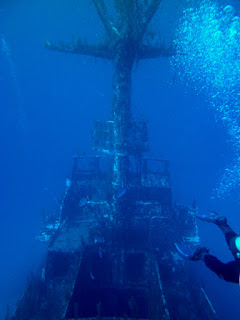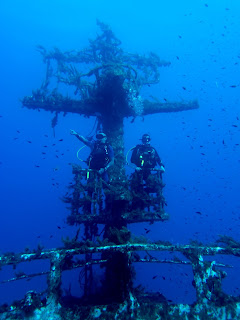Santa Maria Caves is one of the most visited dive sites. There is a small cove where your boat will set anchor; take a bearing for the far corner of the cove. That is the entrance to the first cave you can see from land as tourist boats enter the cave. Once off the boat you can descend to the sandy sea bed and feed the sea bream as they come 30 to 40 at a time to grab bread.
Moving on from the feeding frenzy, take your bearing across the cove, follow the cave to the end and to the left, at two metres, the tunnel branches off into a small bell chamber big enough for four divers to go in and see the immense bright sapphire blue from the ocean outside. Heading back out of the cave keeping to the left under the arch and back out to the sea, keep following the wall around five metres, and you will enter the main cave entrance. From here the cave splits into a Y shape. Keeping right brings you back out, keeping left takes you deeper in. Following to the left you come to a ledge.
As you rise to the top you notice the route off to the right. Keep to the left, and ascending you will surface in an air chamber inside the cave where you can climb out. Take a moment to take in the view and descend again, heading off the ledge and back down to the cave floor. You will notice sunlight, and not far away is the exit to the cave. Heading out into the open to your left there will be a big overhang.
You will see the arch, swim through a ZORO ‘Z’; once through ZORO you will see some boulders below at 15-18 metres. Swim back around the reef to your right. Following the wall around you re-enter the cave staying on the right side. Once inside you come to a narrow passage. Swim through this, it looks tight but you can pass with twins, once out and the whole group has reunited outside, swim straight out and you should find yourself underneath your boat. If caves are not your thing you can stay outside on the reef. It is fantastic for kids’ snorkelling, and this site has been used as the
location for many films in the past. As for marine life you’re sure to see sea bream, also stingrays down on the sand and octopie morays along with passing amberjacks.
Tuesday 5 April 2016
Monday 4 April 2016
HMS Stubborn S-Class Sub.
HMS Stubborn was an S-class submarine of the Royal Navy, and part of the Third Group built of that class. She started life on 10 September 1941 Cammell Laird Shipyard (Birkenhead, U.K.) and launched on 11 November 1942. So far she has been the only ship of the Royal Navy to bear the name Stubborn. While on patrol in the Bay of Biscay, she fired torpedoes at a group of three German submarines (U-180, U-518, U-530) escorted by two destroyers. The torpedoes however missed their targets and the attack was not observed by the Germans. The two escorts were identified by Stubborn as Narvik-class destroyers. The German submarines were returning from patrol and were bound for Bordeaux.
Stubborn also made an unsuccessful attack on a German
convoy off the Follafjord, west of Namsos, Norway, and on 11 February 1944, she
sank the German merchant Makki Faulbaum and torpedoed and damaged the
German merchant Felix D. some 25 miles north-west of Namsos, Norway. She
later made an unsuccessful attack on a German convoy of five ships off the
Folda Fjord, Norway. Stubborn fired six torpedoes but none found their
target. Stubborn was heavily damaged by the German escort ships and had
to be towed home, with her crew acting as human "balance weights" to
maintain the submarine on an even keel when her after hydroplanes were jammed
"hard-a-dive”. Stubborn was transferred, arriving in mid 1945, but
had a distinguished career there before the war ended. She sank the Japanese
patrol vessel Patrol Boat No.2 (the former destroyer Nadakaze) in the Java Sea.
The survivors were shot in the water. She went on to sink a Japanese sailing vessel
and an unidentified small Japanese vessel. Stubborn survived the Second
World War and was sunk on 30 April 1946 as an ASDIC
target off MALTA
This boat
dive is about 30minutes out from st, Pauls bay
Now sitting
on a sand bed at 57 meters this is a technical diver due to depth and time. Descending
down the shot line on a good day at 30 meters the outline of the sub should
come into view through the crystal clear waters, once on the wreck you will
notice it has a slight list.
There are 2
hatches on the forward deck and 1 on the coning tower is open...DO not enter!.
The wreck itself is perfectly intact, conning tower, torpedo tubes and
propellers. For the photographer even at this depth you can still get great
shots. Marine life is limited due to open sea and at depth some divers do report
large shoals of jack/ tuna and sea bream.
SS Polyneien (Ocean liner)
The shipping side of the government-owned 'Messageries
Nationales' was split in 1852 under the name 'Compagnie des Services Maritimes
des Messageries Nationales' and by 1857 it owned 57 ships. In 1871, the company became 'Compagnie des Messageries
Maritimes'. In 1904 the fleets of Compagnie Francaise de l'Est Asiatique and
Compagnie Nationale de Navigation were taken over.
Polynesien SS was French Ocean passenger(243 people) steamer of 6,373grt that
was torpedoed and sunk by German submarine UC-22 when 7 miles off Grand Harnour
, Valetta, Malta on the 10th August 1918 when on route from Marseille &
Bizerta for Salonica.
Built in 1890, the passenger Ocean
liner Le Polynesian. with a length of 152 meters 15 meters high 10
meters wide her size is unimaginable till you see her.
Her depth has protected Le Polynesien’s treasures from plunderers, unlike those of
more shallow wrecks. Inside you can still find a lot of china and other objects
that bear witness to the times when the steamship operated first as a cruise
liner and later as an armed troop transport,Now, huge decks lie open to divers who enter the wreck through
various holes and hatches.
I remember one dive i had on her the visibility was great but we had strong current, i looked down and i could see the shot line curled up on the anchor and looking from 36 meter i cant believe we missed the wreck,until we got to 45 meters and realized i was looking at the porthole,sitting on the mid deck at 56 meters we head off to the stern and drop down inside the wreck post of all the walls have gone making it easier to swim through,the deck below was filled with light filtered through various openings. dropping deeper into the wreck you can still find lots of artifact bottles of perfume or bottle of red wine but she is littered with 3 types of plates so with markings and some are just plain white and then you have the ship markings on the plate rim.
still with the deck guns fitted aiming slightly up this time they didnt help save here, the prop is the jaw dropping feature and it just make you feel so small... with the shallow end of the wreck at 55 meters the prop being the deepest at 70 meters.
Thursday 17 March 2016
HMS HELISPONT
She was a robust ship built for deep sea rescue paddle wheeled steamer tug, and was built in 1910 in Hull, first she started work in Queenstown Ireland till early 1920s, were she was sent then to Malta were she worked around the island till the night of 6th april 1942, during air raid on the harbour she was hit by Italian bombers, she was salvaged and towed out of the harbour and scuttled.
She was re-discovered in 1999 and She is a victim of the intense bombing Hellespont is a relatively recently discovered wreck off the Grand Harbour,the bow section about 12-15 meters is missing possible still in the harbour or just totally destroyed but who knows, i have dived around the wreck and not found it yet!
She sit perfectly upright, and the damage can been seen as you swim over her, with cables hanging from her with caution you can get down inside her and see the boilers and hatches and see the piston rods, she is just a fabulous wreck to dive on,
With her gaf hook on the main deck, hatches still in tact the stern section still has live ammo and the sea bed littered with live ammo its just one of my favorite dive sites portholes still were they should be not on peoples walls
This is entry level technical dive due to her depth and if visiting Malta this is one wreck you don't want to miss out on.
Friday 11 March 2016
P29 Patrol Boat
She was then used to patrol costal water around malta with immigration and smuggling at the top of their list of daily patrols, till she was then decommissioned in 2004, And she was bought by Malta tourism authority in 2005,with plans to turn her into an artificial reef for divers which took place on 14th August 2007 after she was cleaned from all marine pollutants and oils.
Now sitting just off the coast of cirkewwa port at a depth of 33 meters and sitting up-right, once in the water at the training area, swim to the ledge which is around 5/6 meters deep, you should see the drop off to 22/25 meters now take a bearing 320.c and follow out for aprox 110/120 meters, watch out for strong currents, now you should be on the stern, swimming towards the bow a lot of the doors have been removed to make it easier to enter the wreck, it’s a great wreck for penetration, and for beginner’s to learn more about deep wrecks and what’s involved, penetration recommended to do with guide and for more experienced divers due to depth and overhead environment.
Now on the bow a deck gun has been made and fitted by local divers which is great for u/w photos as we leave the deck gun heading back up to the bridge you can enter with care as its tight but you can swim round it easily then move a bit shallower to the crow nest and here it is normally full of squid/calamari eggs hanging in pearl white strings like pearl necklaces, staying at this level around 17 meters you can start heading back to land, as you swim across the exhaust stacks watching other divers swimming onto her, now you have left her behind you think about what you have seen and its full of marine life, from eagle rays, groupers to barracuda swimming around her hull while upon the ship morays sticking their heads out of holes and on the hand railings and decks can be found covered in brightly colourful Nudibranchs of all types sizes and patterns’ they are just to beautiful to take photos of.
Subscribe to:
Posts (Atom)
























